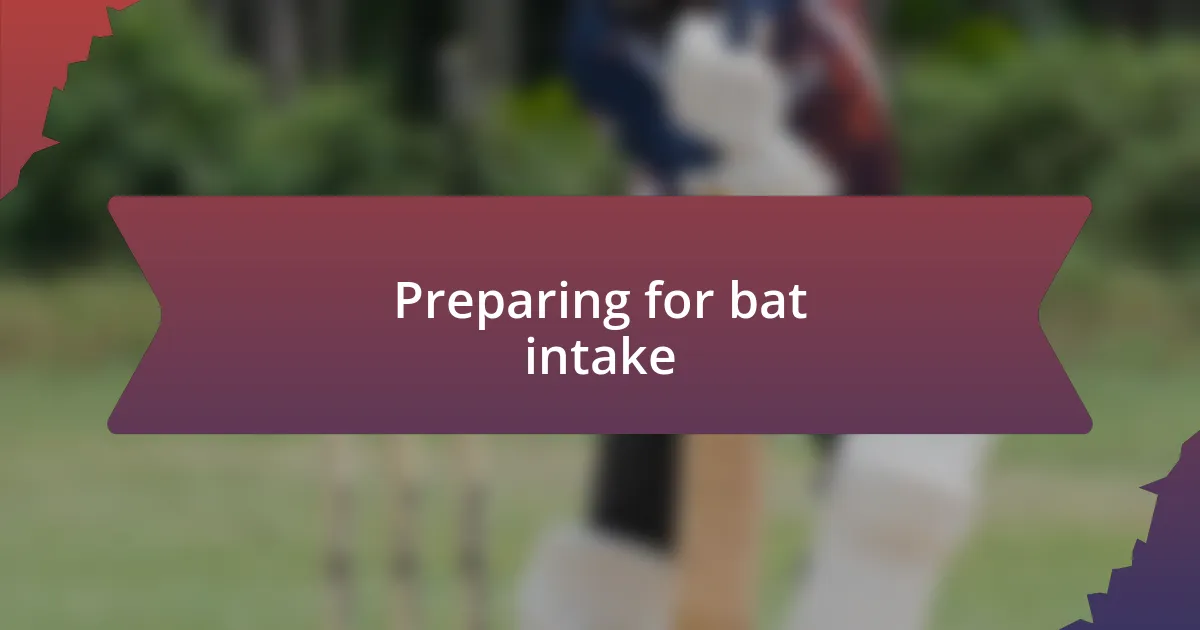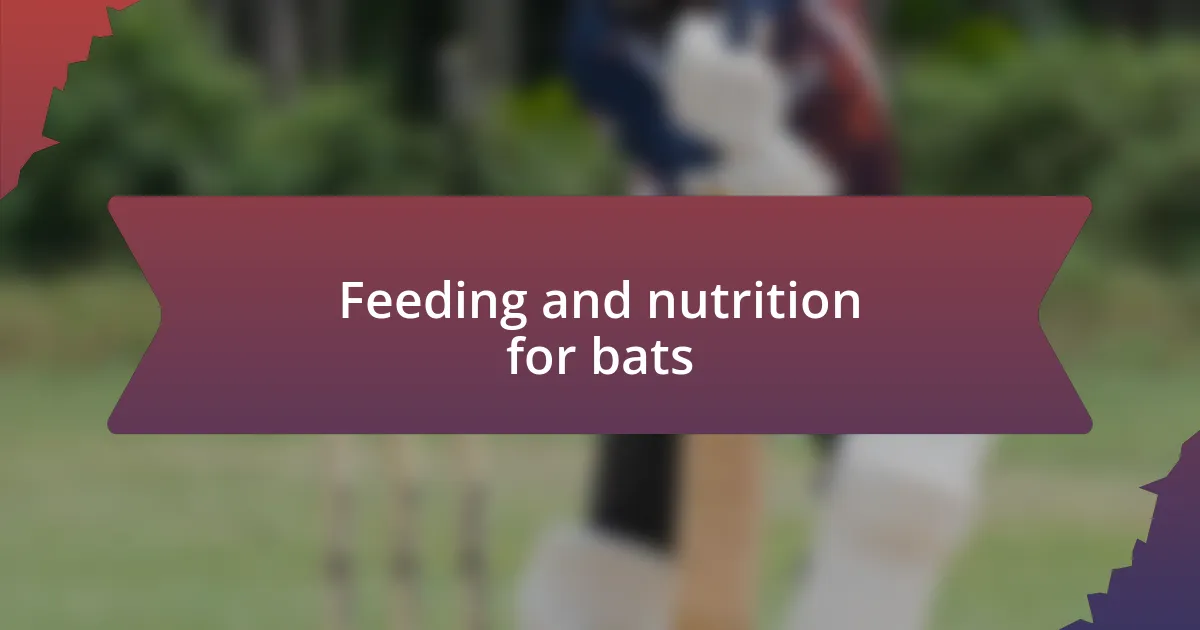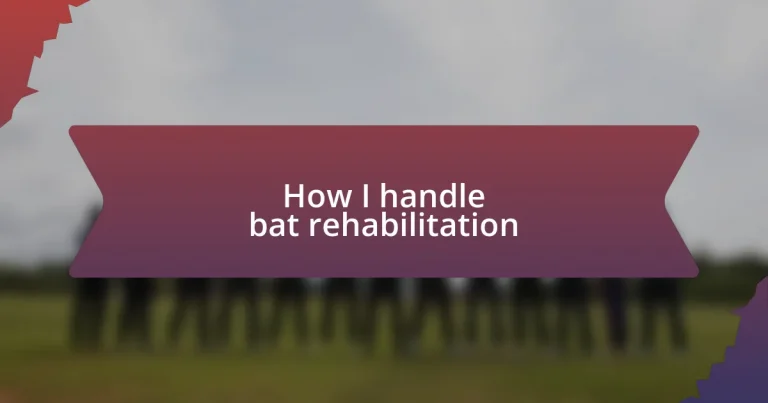Key takeaways:
- Bat rehabilitation requires understanding both the emotional and physical needs of the animals, as social environments are crucial for their recovery.
- Creating a suitable habitat involves elements like temperature control, secure enclosures, and natural materials to reduce stress and promote comfort.
- Feeding must replicate the bats’ natural diets and take into account species-specific nutritional needs to ensure their health and vitality.
- Common rehabilitation challenges include acclimatization to captivity, managing sudden health issues, and encouraging natural flight behaviors in rehabilitated bats.

Understanding bat rehabilitation
Bat rehabilitation is a delicate process that requires not only technical knowledge but also a deep emotional investment. I remember the first bat I helped rehabilitate; its tiny body was trembling, and I felt an overwhelming urge to protect it. This experience taught me that understanding their needs goes beyond basic care; it involves recognizing their emotional and physical vulnerabilities.
When I think about the key components of bat rehabilitation, I often reflect on their social nature. Did you know that many bat species are incredibly social and rely on their colony for support? Just like us, bats thrive in a community, and isolating them during recovery can be stressful. I recall a particularly difficult recovery of a juvenile bat that had lost its colony. I made it a priority to mimic that social interaction, using gentle sounds and encouraging its natural behaviors. It was heartening to see how it responded, and it reinforced my belief in the importance of a supportive environment.
In my journey, I’ve learned that attention to detail is crucial. For instance, the specific dietary needs of bats can vary widely depending on their species. One time, I had a bat that was initially reluctant to eat because it was used to catching insects. After experimenting with various feeding techniques, especially offering live insects, that little one began to thrive again. Have you ever considered how small adjustments can lead to significant results? Each bat I’ve rehabilitated has taught me something new about their unique needs and the patience required to assist their recovery.

Preparing for bat intake
When preparing for bat intake, the initial step involves setting up a dedicated and secure space. I remember the frantic moments when I received my first unexpected bat, and all I had was a dimly lit room with old blankets. It hit me how crucial the environment is; now, I make sure to create a warm, quiet, and comfortable area that mimics their natural habitat, making a significant difference in their recovery.
Here are some essential elements I consider essential in this preparation phase:
– Temperature Control: Bats are sensitive to temperature. I always ensure the intake area maintains a stable, warm temperature.
– Secure Enclosure: A sturdy, escape-proof enclosure is vital. I learned this the hard way when one bat slipped through a gap, leading to a frantic chase.
– Natural Materials: Incorporating elements like branches or foliage provides a familiar environment; I’ve seen how much more at ease bats feel when they have something to cling to.
– Quiet Space: Minimizing noise and distractions helps reduce their stress levels; I often play soothing sounds to keep them calm.
– Hygiene Supplies: Having clean food dishes and bedding ready is fundamental; a clean environment supports their immune system as they heal.
These considerations have evolved through many experiences, reinforcing the importance of thoughtful preparation for each bat’s unique situation.

Assessing the bat’s health
Assessing a bat’s health is a meticulous process that requires keen observation and a compassionate touch. I remember the early days of my rehabilitation journey when I found myself bewildered by the subtle signs of distress in a bat. One bat in particular, named Luna, appeared lethargic and disheveled. I closely examined her body condition, noting her weight and assessing any injuries or signs of illness. This attention to detail was crucial, as it allowed me to tailor her recovery plan effectively.
Another key aspect of health assessment is checking for dehydration. I’ve learned to gently pinch the skin on their back and watch how quickly it returns to its original position. If it takes longer than usual, that’s my cue that they might need immediate fluids. Each interaction during this assessment deepens my understanding of their needs. It reminds me that they are not just animals in distress; they’re delicate beings that require our care.
To better understand the various factors involved in health assessment, I’ve created the following comparison table:
| Health Assessment Criteria | Importance |
|---|---|
| Body Condition | Indicates overall health and weight loss or gain. |
| Signs of Dehydration | Crucial for preventing further complications; signifies immediate treatment needs. |

Creating a suitable habitat
Creating a suitable habitat is essential for a bat’s rehabilitation and recovery. When I first began my work with bats, I realized that replicating their natural environment as closely as possible was key. For instance, I often use a variety of roosting options – from wooden boxes to fabric hammocks, each providing a different texture and shelter. This diversity allows the bats to choose their preferred resting spots, minimizing stress and promoting comfort.
Furthermore, the right temperature and humidity levels can make a world of difference. I can vividly remember the time I nearly lost a bat named Echo due to an improperly heated enclosure. Soon after adjusting the temperature to mimic their natural habitat, I saw her thrive as she began to explore and feed. Observing how critical these environmental factors are has greatly shaped my approach to habitat creation.
Finally, I can’t stress enough the importance of safe spaces. When a bat feels threatened, it can lead to further stress or injury. I often include various hiding spots within their habitat, like branches or leaves, so they can retreat when feeling anxious. Have you ever noticed how much more relaxed animals can be when they have the choice to hide? It’s these small yet significant adjustments that truly provide a nurturing environment for our rehabilitated friends.

Feeding and nutrition for bats
Feeding and nutrition are vital components of bat rehabilitation that often get overlooked. I’ve found that understanding their diet in the wild helps me replicate it accurately in rehabilitation. For example, while preparing meals for my bats, I include various insects like mealworms and crickets, which I’ve learned they typically hunt for. Have you ever seen a bat deftly pluck insects out of the air? Recreating that experience with live food can energize them and stimulate their hunting instincts.
The nutritional needs can vary significantly between species, so I pay close attention to each bat’s requirements. One time, I was surprised to discover that a little brown bat benefits from a higher protein content than I initially thought. Adjusting the dietary balance not only improved its energy levels but also its overall health. It was rewarding to witness this transformation firsthand—who knew a few extra bugs could make such a difference?
Furthermore, I emphasize the importance of hydration. Bats can sometimes be reluctant to drink, which can lead to dehydration and health issues. I remember once watching a little bat hesitant to sip water from a bowl. After I adjusted its enclosure to feature dripping water from a small sponge, it happily drank and even bathed. Isn’t it fascinating how small changes can impact a creature’s willingness to nourish itself? Each feeding session becomes a moment for me to learn and adapt, putting me more in tune with their needs.

Common rehabilitation challenges
While working with rehabilitated bats, one of the most common challenges I face is acclimatizing them to captivity. Many bats are initially stressed and disoriented in their new environment, which can hinder their recovery. I remember a particular instance with a young bat that clung to its box for days, visibly frightened. It made me wonder—how can we ensure they feel secure in a space so different from the wild?
Another significant hurdle is managing the unexpected illnesses that can arise during rehabilitation. I once cared for a bat that appeared healthy but suddenly showed signs of respiratory distress. The panic I felt was overwhelming; how could something so subtle go unnoticed? This experience taught me the importance of vigilant monitoring, showing that even slight changes in behavior can signal deeper issues.
Rebuilding their strength and behavior is yet another challenge I regularly encounter. Some species may be reluctant to attempt flight after being grounded for so long. I recall a moment when a little brown bat hesitated at the edge of its enclosure. My heart ached in that instance—would it ever take that leap of faith? Encouraging their flight instincts involves crafting an environment that fosters confidence, which can be both rewarding and frustrating at times. Each setback reminds me of the delicate balance we must maintain between rehabilitation and their innate behaviors.



